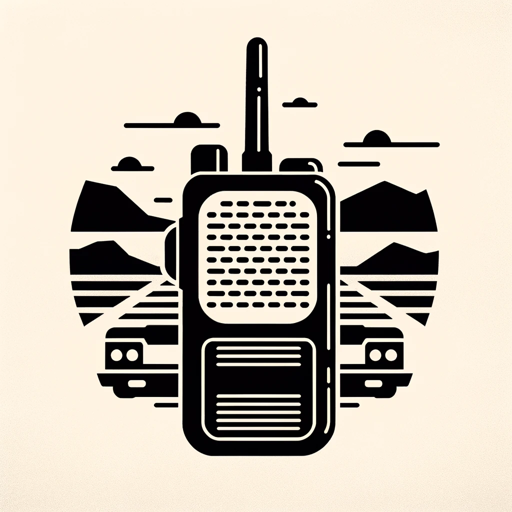HAM RADIO-Amateur Radio Assistance
AI-powered HAM Radio Expertise
How do I set up a portable antenna?
What are the best digital modes for amateur radio?
Can you explain balun and unun?
Tips for efficient QRP operations?
Power sources for portable operations
What is SOTA and POTA ?
What is VSWR ?
Related Tools
Load More
Network Engineer
Provides network design guidance, troubleshoots connectivity issues, and ensures optimal network performance.
Learn GMRS With The NotARubicon!
Learn about GMRS & GMRS Radios with Youtube's most popular hobo. This is the A.I. version of the one-and-only NotARubicon, aka Randolpho Cafe. Ask me anything about GMRS or ham radios, life, or stupid people.

! Marine Navigator !
Adaptive maritime guide for navigation and sea knowledge.

AV Master
AV設備に詳しい専門家。日本語で詳細な情報を提供。

Rock Radio KI Assistent
Hey ich bin ROC[KI] dein digitaler Assistent für viralen Rock Radio Content

HomeLab Guru
Balanced, adaptable expert in home/small business tech solutions
20.0 / 5 (200 votes)
Introduction to HAM Radio
Amateur Radio, often referred to as HAM Radio, is a popular hobby and service that brings people, electronics, and communication together. People use ham radio to talk across town, around the world, or even into space, all without the Internet or cell phones. It serves as a reliable communication method during emergencies, promoting community service and scientific research. HAM radios are designed to facilitate personal wireless communication. They come in various forms, including handheld transceivers (HTs), mobile transceivers, and base station setups. Each type is suited to different scenarios, from casual conversations and contesting to emergency communications and experimentation. For example, during natural disasters when conventional communication systems fail, HAM radios become invaluable for emergency response coordination.

Main Functions of HAM Radio
Emergency Communication
Example
HAM radio operators provide vital communication during emergencies, such as natural disasters.
Scenario
During Hurricane Katrina, HAM radio operators helped coordinate rescue efforts when all other communication systems were down.
Technical Experimentation
Example
Operators experiment with different antenna designs and digital modes.
Scenario
A HAM enthusiast builds and tests a new end-fed half-wave antenna to optimize performance for different HF bands.
International Communication
Example
HAM radio allows communication with people globally.
Scenario
An operator in the United States makes contact with another operator in Japan, exchanging signal reports and technical information.
Ideal Users of HAM Radio
Emergency Responders
Emergency services and volunteer organizations benefit from HAM radio for reliable communication during disasters when regular networks fail.
Hobbyists and Enthusiasts
Individuals interested in electronics, communication technologies, and DIY projects use HAM radio for personal enjoyment and technical experimentation.

How to Use HAM RADIO
Visit aichatonline.org for a free trial
Visit aichatonline.org to access HAM RADIO for free without needing to log in or subscribe to ChatGPT Plus.
Select the appropriate band and mode
Determine which frequency band (HF, VHF, UHF) and mode (SSB, CW, digital) you wish to use. This depends on your license class and available equipment.
Set up your transceiver and antenna
Connect your transceiver to a suitable antenna for the band and mode you've selected. Ensure all connections are secure and the antenna is correctly positioned.
Tune your transceiver
Use the tuning function on your transceiver to minimize SWR and optimize signal strength. This may involve adjusting the antenna length or using an antenna tuner.
Begin operating and logging contacts
Start making contacts by calling CQ or responding to others. Log your contacts with details such as call signs, signal reports, and QTH (location).
Try other advanced and practical GPTs
CB Radio Chat With Friends
AI-Powered CB Radio Experience

SAFe Tutor
AI-powered tool for mastering SAFe 6.0.

Medical Student Tutor
AI-powered tutor for medical mastery.

MBA Student
AI-powered MBA Study Assistant

LINEスタンプクリエイター
AI-driven tool for creating unique LINE stamps.

Simple Line Drawing
AI-Powered Line Art for Creativity

Typography Genius
AI-powered typography guidance at your fingertips

Spring Boot 3 도우미
Optimize Spring Boot 3 with AI Assistance

Spring Boot React Expert
AI-powered full-stack development expertise.

Master Spring TER
AI-powered Spring Framework Expert

Online Ai image editor | Free Online Photo Editor
AI-powered photo editing made easy.

Tattoo Designer
AI-Powered Custom Tattoo Designer

- Troubleshooting
- Regulations
- Portable Ops
- Digital Modes
- Antenna Setup
HAM RADIO Q&A
What equipment do I need to start using HAM RADIO?
You need a transceiver, an antenna, a power supply, and a microphone or key for voice or Morse code communications. Additionally, an SWR meter and an antenna tuner can be very helpful.
How do I choose the right antenna for my setup?
Choose an antenna based on the bands you wish to operate on, space available, and your budget. Common options include dipoles, verticals, and end-fed antennas. For multiband operation, consider an off-center-fed dipole or a trapped vertical.
What are the common digital modes in HAM RADIO?
Popular digital modes include FT8, FT4, RTTY, PSK31, and JS8. Each mode has its own characteristics, and software like WSJT-X or FLdigi can be used for these modes.
What is the importance of an antenna tuner?
An antenna tuner matches the impedance of your antenna to your transceiver, minimizing SWR and ensuring efficient power transfer. This is crucial for reducing loss and protecting your equipment.
How can I participate in portable operations like POTA or SOTA?
For portable operations, select lightweight and compact equipment. Use portable antennas like end-fed half-waves or verticals. Ensure your power source is reliable, and always follow safety guidelines.